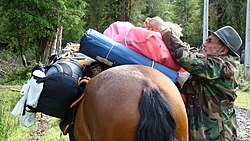Arriero

Anarriero,muleteer,or more informally amuleskinner[1](Spanish:arriero;Portuguese:tropeiro;) is a person who transports goods usingpack animals,especiallymules.
Distribution and function
[edit]In South America, muleskinners transportcoffee,maize (corn),cork,wheat,and myriad other items. They used to be common in thePaisa Region(Antioquiaand theColombian Coffee-Growers Axis) ofColombiabut were replaced in the 1950s by tractor trailers called locally "tractomulas" paying homage to the mules that used to do this hard job. InCalifornia,muleteers work out ofpack stations.In Europe, there are still muleteers in the south ofPortugaland the southwest ofSpain,in the cork producing area. Their role is now limited to transporting the cork with their mules, out of the Mediterranean oak forest to more accessible routes, where modern means of transport are available.
Names and etymology
[edit]The English wordmuleteercomes from theFrenchmuletier,fromOld French,frommulet,diminutive ofmul,mule.The termmuleskinnermeans someone who can "skin", or outsmart, a mule.
TheSpanishwordarrierois derived from the verbarrear,which means to urgecattleor other stock to walk. The verb itself is derived fromarre,which is the call used to cry out to animals for this purpose. In English, anarrierois one type of muleteer, awranglerof pack animals.[citation needed]
TheCatalanwordtraginercomes from theLatinwordtragīnare,a variant oftragĕrewhich means "to transport".

Outfits
[edit]Typical muleteer outfits vary from country to country:
- Carriel:Leather bag traditionally made ofnutrialeather. It is used to carry personal goods and money. It has become an element of the Colombian fashion.
- Espadrilles(alpargatas): Sandals made offique(natural fiber obtained offurcraeaplants and leather.
- Machete
- Poncho:Rectangular piece of fabric, usually white with linear embroidery, that is used to protect the face and neck from the cold weather.
- Ruana:Square wool garment, larger than the poncho, with a hole in the middle for the head. It covers the torso.
- Strawhat(sombrero aguadeño)
- Tapapinche:Leatherapron.
In popular culture
[edit]The fictionalJuan Valdez,brand representative of theFederación Nacional de Cafeteros de Colombia,is an archetypal muleteer carrying coffee sacks with his mule.
InCormac McCarthy's secondBorder Trilogynovel,The Crossing,Billy's wolf upsets the muleteers' burros, which wreaks substantial havoc before Billy moves on.[2]
"Mule Skinner Blues"is a country music song first recorded in 1930 byJimmy Rodgers,which has inspired many subsequent variations.
The 1964 Broadway musicalMan of La Manchafeatures a band of muleteers as one of the primaryantagonists.

See also
[edit]- Igualada Muleteer's Museum
- Teamstersdrove animals pulling a wagon.
- Mule drivers of Metsovo
- Tropeiro(equivalent ofarrieroinBrazil)
References
[edit]- ^"mule skinner | Define mule skinner at Dictionary".Dictionary.reference.Retrieved2020-01-15.
- ^McCarthy, Cormack.The Crossing.pp. 24–25 (Book Index 5).
